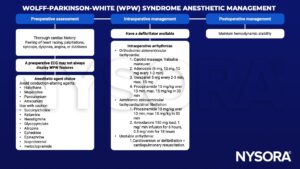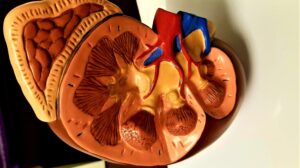Learning objectives
- Describe the mechanisms & symptoms of Wolff-Parkinson-White Syndrome
- Manage patients with Wolff-Parkinson-White Syndrome
Definition & mechanisms
- Wolff-Parkinson-White Syndrome (WPW) is a congenital abnormality that involves the presence of abnormal electrical conductive circuits between the atria and ventricles, resulting in accessory electrical pathways that bypass the AV node
- Can result in life-threatening arrhythmias
Signs & symptoms
| Electrocardiographic signs | Short PR interval |
| Prolonged QRS |
|
| Initial slurring upstroke (“delta” wave) in the presence of sinus rhythm |
|
| Clinical symptoms | Palpitations |
| Episodic lightheadedness |
|
| Presyncope |
|
| Syncope |
|
| Cardiac arrest |
Management

Suggested reading
- Bengali R, Wellens HJ, Jiang Y. Perioperative management of the Wolff-Parkinson-White syndrome. J Cardiothorac Vasc Anesth. 2014;28(5):1375-1386.
We would love to hear from you. If you should detect any errors, email us [email protected]








